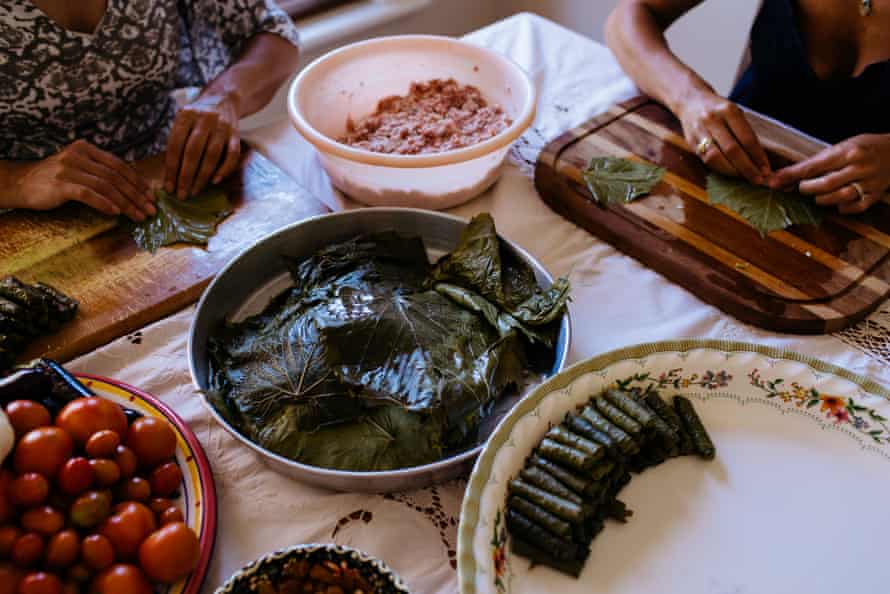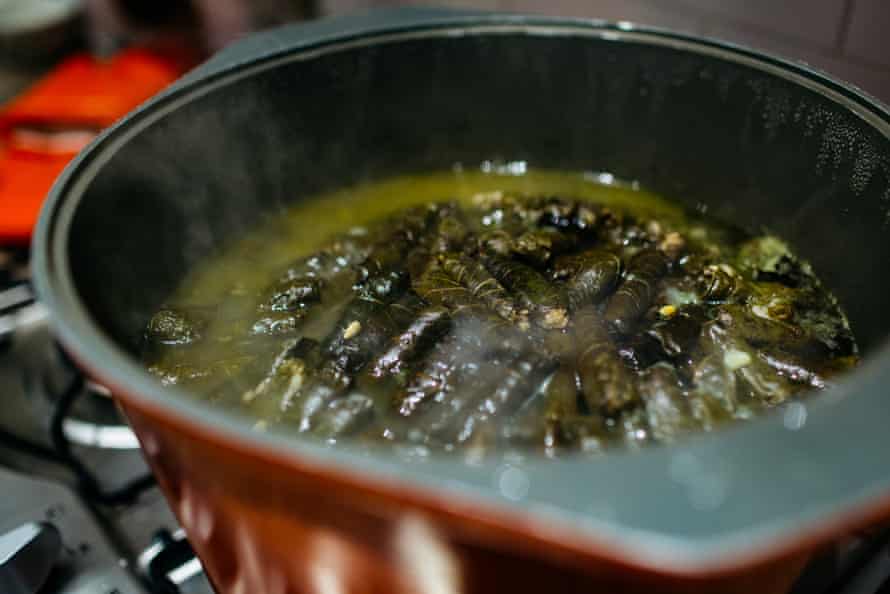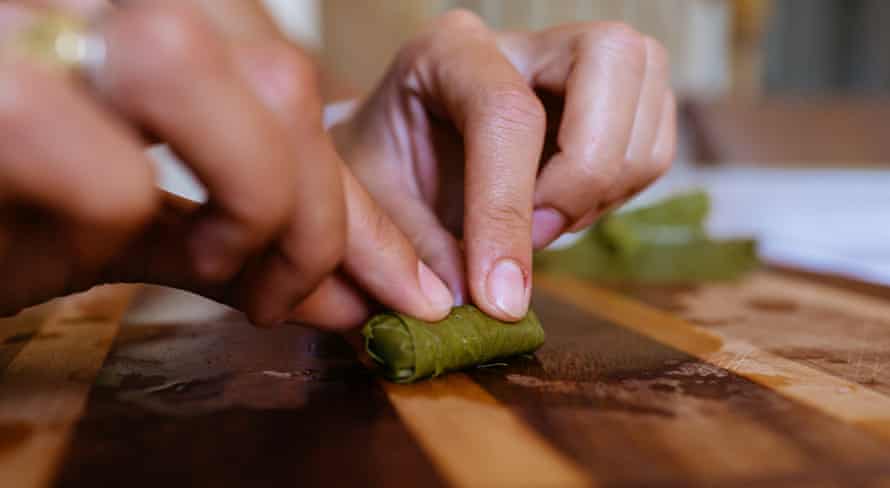Just-Right Recipes - The New York Times |
- Just-Right Recipes - The New York Times
- How to make 2 classic recipes from 'Cook Real Hawai'i' - GMA
- Recipes for Ramadan: Karima Hazim’s warak enab (stuffed vine leaves) - The Guardian
- New Book, Uncommonly Good, Shares Recipes and a Story of Shared Dreams – Food Tank - Food Tank
|
Just-Right Recipes - The New York Times Posted: 14 May 2021 09:30 AM PDT  The sun is out. I've made my annual switch to iced coffee. I'm buying Lambrusco and making a spritz. Summer is nigh! After the year we all had, you will catch me indoors only when it's time to sleep, shower or type on this laptop (and maybe not even then). But, OK, let's still take a beat to revel in spring. Many of the recipes below are gloriously green, and all are just the right heft for this in-between moment. Best of all, they are legitimately easy to make (which, again, after the year we all had... ). Tell me how you're doing: I'm dearemily@nytimes.com, and I love to hear from you. 1. Glazed Tofu With Chile and Star Anise I love making new recipes from Yewande Komolafe, especially ones with tofu: She just has a way with it. This recipe for this dish, which is inspired by Sichuan hui guo rou, or twice-cooked pork, has you searing whole blocks of tofu, tearing them into pieces and then tossing them in a darkly sweet sauce with rice wine, soy sauce, ginger and scallions. 2. Crispy Grains and Halloumi With Smashed Cucumbers The vegetarian sheet-pan meal you need is here. In Ali Slagle's highly customizable new recipe, you can use brown rice, wheat berries, farro or a mix of grains; halloumi or feta; and lemon, lime or grapefruit. Chickpeas bring heft. Crispness brings joy. Cook the grains ahead, if you can, for a very fast dinner. _____ 3. Roasted Salmon and Brussels Sprouts With Citrus-Soy Sauce Here's another truly delicious, no-brainer recipe from Ali Slagle, a fast meal made even faster if you buy shredded brussels sprouts. Put the pan in the oven, stir together a simple sauce of citrus juice, rice vinegar and soy sauce, and serve. I like it with rice. This is Kay Chun's recipe for the Japanese classic, a comfort-food dish of breaded pork or chicken cutlets served with tangy tonkatsu sauce. Kay's method delivers a remarkably crisp crust and juicy meat, and while you could buy the sauce, her homemade version keeps indefinitely in the fridge and is good on everything. _____ |
|
How to make 2 classic recipes from 'Cook Real Hawai'i' - GMA Posted: 15 May 2021 02:07 AM PDT [unable to retrieve full-text content]How to make 2 classic recipes from 'Cook Real Hawai'i' GMA
|
|
Recipes for Ramadan: Karima Hazim’s warak enab (stuffed vine leaves) - The Guardian Posted: 14 May 2021 08:47 PM PDT Warak enab is to Eid what turkey is to Christmas. For the majority of Muslims from Lebanon and the surrounding Levant, this dish of lamb and stuffed vine leaves traditionally graces the Eid table at the end of Ramadan. After a month of fasting, the three-day festival of Eid al-Fitr literally means the festival of the breaking of the fast. Warak enab is usually made in such large quantities that, just like turkey, it is served and enjoyed for several days. This year, 15 May is the third day of Eid, and families across Australia and across the Middle East will be enjoying the leftovers. Last year with the first Covid lockdowns, it wasn't possible to host or to visit extended family and friends, and many of us found ourselves at a loss catering for small numbers. When I cook, I tend to cook for my little family of four, plus my two sisters, my mum and my mother-in-law, portioning food out into Tupperware containers and dropping meals round. It was quite a challenge thinking small. When it came to Eid, I made vine leaves enough for 12 and ran my own Covid-safe delivery service instead. We are so thrilled that this year we can all be together – at least to a maximum of 20 people. When I see, touch, smell and taste warak enab being cooked, I am immediately transported to my tayta's house in Lakemba, western Sydney. A few days before Eid, we would sit on the floor there, rolling vine leaves.  My grandmother, Tayta Amineh, had 15 children, my mother Sivine being number 14. Growing up terribly poor in Tripoli, a historic port city in the north of Lebanon, Tayta Amineh became resourceful at an incredibly young age. Before the war broke out, she helped establish my grandfather's mahal helou, a sweet shop which grew into a bit of an empire. She would sell cheap, homemade toffees to the poorer areas of the city, riding on a donkey (her dowry). With the success of the sweet shops, the family became middle class and Tayta Amineh relied on her "village around her" as support for raising her own large family. Meals were something she "declared" to her neighbours, especially when it came to warak enab, which was made for a variety of special occasions, from Eid to weddings or the birth of a child. She would source all the ingredients, the meat, leaves, rice and spices, and set a date. Then her community of women came together to roll these tiny, delicate parcels, a characteristic of warak enab from Tripoli. Together they made enough meals for everyone's family to enjoy, and they shared. They shared stories of their life, their everyday struggles of family, marriage and home life. This communal act of rolling and preparing a meal became a source of therapy to my Tayta Amineh and her community.  My mother was 11 when her parents moved to Australia. When she left school, she became a social worker. She worked in family support and I recall her asking my tayta (her mother) about mental illness she might have experienced growing up and raising such a large family. My grandmother's answer was simple: "We had a community, a village, not like we have here – we would cook together and talk and share, that was our therapy, we had each other's back, as sisters, as neighbours, as women. We had the funny woman that had a joke for every struggle. We had a resourceful woman who would problem-solve. We had the herbalist with a remedy for everything. We looked after each other." Stuffed vine leaves are a communal exercise and a labour of love. When Tayta cooked warak enab, it would even take three women to tip over the deep pot to serve it up! Everyone would then eat from the deep tray of vine leaves, lamb, bone and marrow. I am forever grateful for those memories. Nowadays, every Ramadan it's Mum who declares when we will be rolling vine leaves, just as my Tayta used to. Year after year, as we sit down and roll, it is the stories I look forward to most. As a large family, there were often communication barriers. So many emotions lost in translation, migration and settlement in Australia. But connection was always found when cooking. The preparation is still a therapy. Mum reminds me all the time: "Tayta's love language was food." These days, with two young ones of my own, I really miss my Tayta. I have so many questions about life I wish I could have asked her. Fortunately, when I take the time to sit and prepare her favourite dishes, I find some of the answers I am looking for. Warak enab asks you to slow down, it begs for your attention, care and precision, it invites you to share with those rolling with you. You are left with a sense of accomplishment, relief, and of course the indulgence of a delicious meal. I would be distraught if my children grow up not knowing how to make this, not having some understanding of how the vines are grown and tended. It's an important part of my inheritance and I want it to be part of theirs. First and foremost, you need to locate fresh leaves – worthy of the hours of rolling you are about to endure. Traditionally, such leaves came from a relative with a vine growing in their backyard, but in Australia, you can buy them from any Lebanese grocery store. Then it is about the roll – hours of stories, laughs, debates and distractions – whether in a group for efficiency, or just with my mum, Fairuz playing in the background. The recipe and method I've shared below is the traditional one; the way it has been done for generations, most likely for centuries. In a way it's a guide rather than an exact recipe. As with all cooking, particularly traditional Lebanese cooking, tasting and smelling along the way is extremely important.  There are many ways to roll, stuff and cook vine leaves, depending on where you're from. Our method is to roll them into short, pinkie-sized fingers, packing them tightly in a tall Bessemer pot over a bed of lamb and bone cuts. Today, you can buy premade rolls – they're available in most Lebanese grocers and halal butchers – but you are robbing yourself of the experience. You can use a pressure cooker too, but you're short-changing yourself and your diners of cooking aromas, and the full flavour you only get from slow cooking. Vine leaves are certainly not a dinner for two, or four. It's a dish that brings people together from start to finish. Back in Lebanon, calling around for the leaves usually meant inviting the supplier to the meal, then a few more people to roll, and before you know it there would be 20 or more family members eating from this one pot. That has to be something really special. Try it with friends or your extended family – or with your colleagues. It could be a great team-building exercise for everyone who has lost out on working as a team over the last year. Karima's traditional warak enab recipe
Quantities can be adjusted for smaller groups 300 fresh grapevine leaves (will make one large 10 litre pot) For the stuffing To serve Preparing the leaves Bring a pot of water to the boil and submerge a handful of leaves at a time to blanch them until they turn khaki green. Repeat with all the leaves. Put leaves in a strainer over the sink and run cold water over them to cool down. Allow to cool and then place on a tray ready for rolling. It is important the leaves are cool, so as to not spoil the stuffing mix. While the leaves are cooling, prepare your stuffing mix. Combine the rice, mince, salt and spices in a large bowl by kneading them together with your hands. On a clean, flat, wet surface such as a kitchen counter, lay a leaf flat with the rough side facing upwards and the smooth side of the leaf against the counter. The amount of filling will depend on the size of the leaf, but the aim is to have uniform rolled leaves to allow for even cooking.  The average leaf should be the size of your palm, so ultimately you end up with a roll roughly three-quarters the length of your pinkie finger. The stuffing should be about the thickness of your pinkie, remembering the rice will expand when cooking. If you have two quite small leaves you can place them alongside one another, overlapping halfway, to form a bigger leaf. If you have a giant leaf you can cut it in half down the centre. Place the filling in the centre of the leaf, about a centimetre from the base. Starting from the bottom, roll the leaf over the filling, tucking the edges to create a cylinder shape. The key to rolling the leaves is to stay relaxed, not tense – that way you avoid ripping them. Tip: while rolling, press on the centre of the leaf and pull it towards you to keep it tight. Each piece when rolled should be around 1cm in thickness. Preparing the meat and assembling the pot In a 10 litre pot, melt a tablespoon of ghee and toss the meat and bones over a high heat to seal, adding salt and baharat spice to the pot. Turn the stove off and assemble the meat and bones as compactly as possible in the middle of the pot. Pack the vine leaf rolls in a circle around the edge of the pot, one by one, and into any gaps in between the meat and bones. Repeat until the last vine leaf roll is in the pot. Place a heatproof plate (slightly smaller in diameter than the size of the pot) face down on top of the vine leaves, to press them down, and put a big rock on top to weigh down the plate. Now add six cups of water to the pot. Tilt your pot to the side; if the water gushes to the side you have plenty of water for your 20-hour cooking. Six cups should be enough. If not, add a seventh. Cover with the lid. Cook on high heat for 30 minutes and then turn down to low and leave on the stovetop to cook through overnight. After about 12 hours of cooking, squeeze three lemons (maybe four, depending on personal taste) and add to the pot. Lift the stuffed vine leaves away from the sides of the pot, and swirl the lemon juice all around. Keep tasting the juice of the vine leaves and adjust with more lemon accordingly. By now the liquid in the pot should be a shiny, dark and a rich green colour. Cook on high for approximately 20 mins. Then reduce to medium heat and keep the pot covered for 20 minutes. Uncover the pot and cook for a further 20 minutes. The top layer should sizzle. Serve by tipping the pot into an extra-large, deep serving dish. The stuffed vine leaves should fall to the bottom and the meat should be falling off the bone at the top. This is a two or three-person job! Serve with fresh radish, spring onion, mint and fresh Lebanese bread. Best enjoyed eaten with your hands.
|
|
New Book, Uncommonly Good, Shares Recipes and a Story of Shared Dreams – Food Tank - Food Tank Posted: 13 May 2021 01:51 PM PDT  The recently released book Uncommonly Good tells the story behind the development of the Vermont retreat center Good Commons while providing practical recipes for home cooks. Co-authored by Matthew Wexler and Tesha Buss, the book details the trials and triumphs of the authors' experience building Good Commons. The two friends spent nearly a decade building the center, which today provides space for guests to refuel by slowing down their daily routines and sustaining their bodies with nourishing food. Wexler explains that from the beginning, he and Buss knew that Good Commons would provide visitors with food from local purveyors, something that has become key to the business. "You cross the border [into Vermont] and you roll down the window and all you smell is green and fresh and alive. That absolutely had to be part of the food story of the place," Wexler tells Food Tank. Uncommonly Good also offers readers more than 75 recipes inspired by the authors' Midwestern upbringings, their love of brunch, and Wexler's experiences as a chef in New York City and Chicago. And with the recipes come the stories behind each dish. "I was more interested in the stories connected to the food than writing an introduction to the recipe that is talking about the recipe," Wexler says. "I wanted to give it a framework that had context because when people are at Good Commons and experiencing the food those narratives and that storytelling makes everything taste better." In addition to being entertained by the recipes and stories, Buss readers will be inspired by their book. "Don't be afraid of anything," Buss tells Food Tank. "Don't be afraid of the recipe. Don't be afraid to fail. Just try it." Photo courtesy of Vincent Crossley Join the Conversation: |
| You are subscribed to email updates from "recipes" - Google News. To stop receiving these emails, you may unsubscribe now. |
Email delivery powered by Google |
| Google, 1600 Amphitheatre Parkway, Mountain View, CA 94043, United States | |
from What to Cook https://ift.tt/3uRtW4y
